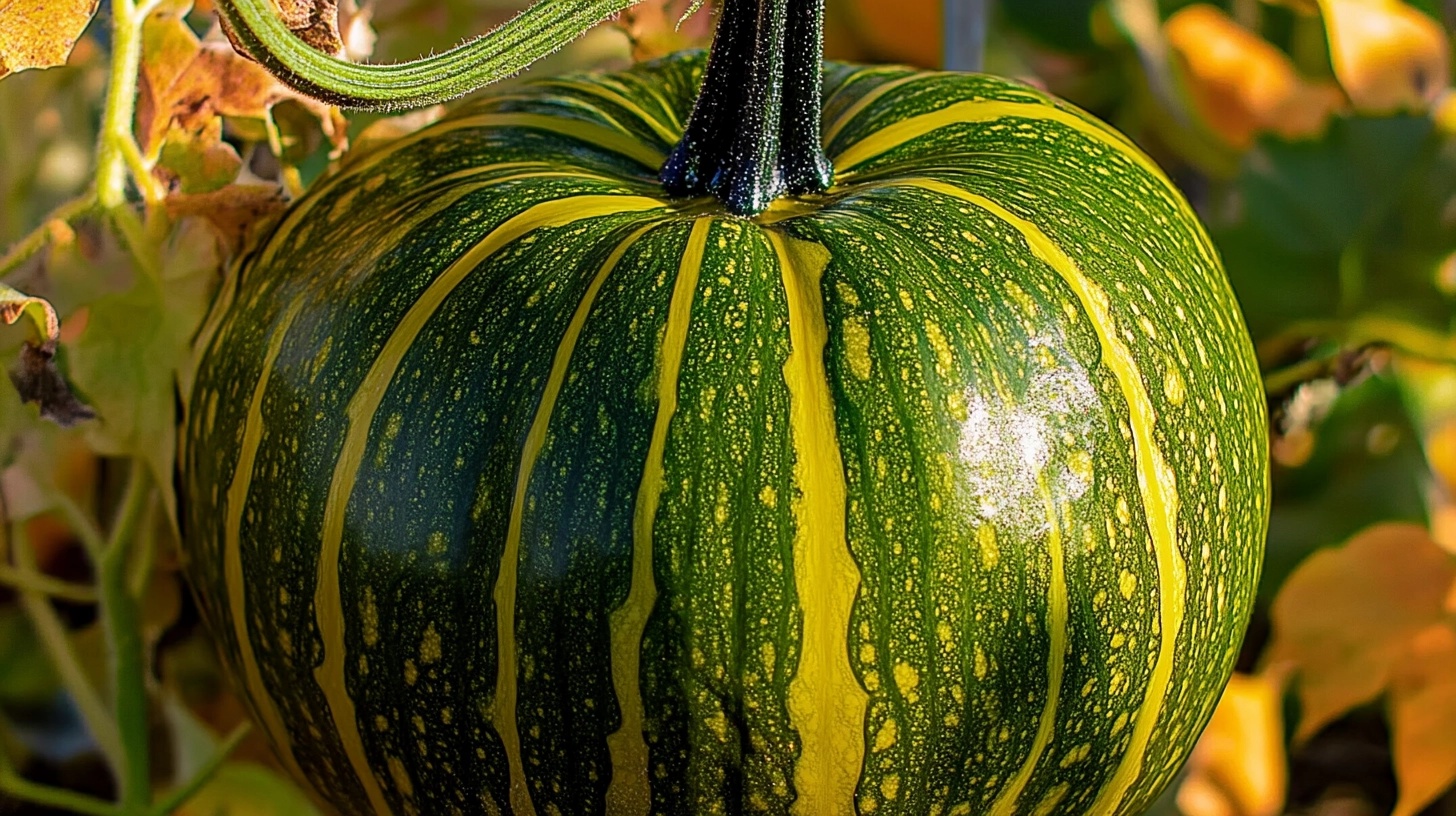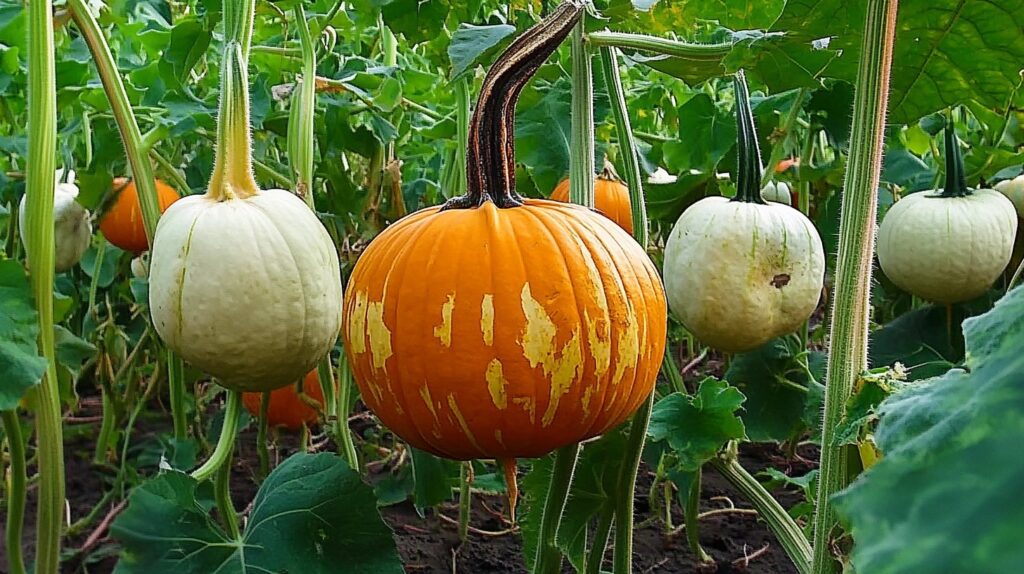The first time I tried growing pumpkins, I naively believed a few bamboo hoops would offer enough support. Within weeks, my garden looked like a scene from a nature documentary—vines snaking into walkways, wrapping around tomato cages, and attempting to scale my porch steps. That was the moment I discovered the true magic of trellising pumpkins.
If you’ve ever been overwhelmed by aggressive vines or want to grow pumpkins in a limited space, trellising pumpkins could be your gardening breakthrough. It not only saves valuable ground space but also improves airflow, reduces pest damage, and results in cleaner, healthier fruit.
Even if you’re gardening on a balcony, patio, or compact raised bed, vertical pumpkin growing is completely doable—and surprisingly simple with the right guidance. Check out these creative small vegetable garden ideas to make the most of every inch while giving your pumpkins room to thrive.
Table of Contents
What You’ll Learn
In this guide, we’ll walk you through everything you need to know to get started with trellising pumpkins effectively:
- Why vertical gardening works wonders for pumpkins
- The best types of trellises (DIY to decorative)
- How to train vines to climb instead of crawl
- How to support those heavy gourds midair
Whether you’re a backyard grower or an urban container gardener, this article is packed with practical, proven techniques to help you succeed.
Why Grow Pumpkins Vertically?
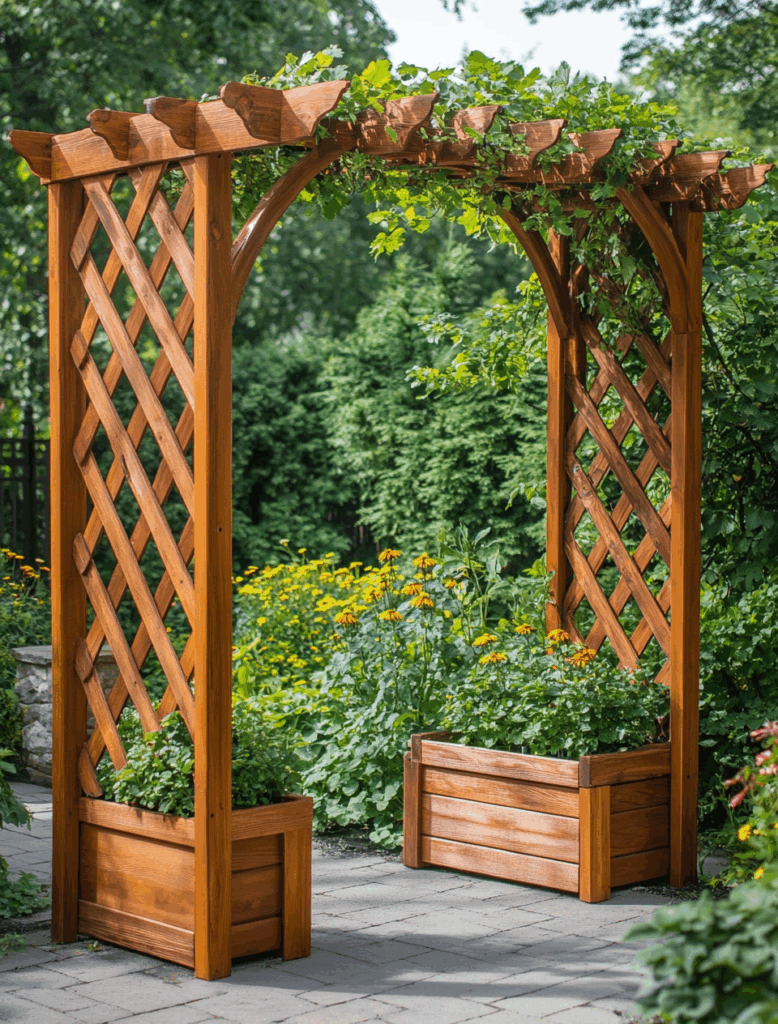
If you’ve ever watched a pumpkin vine stretch across your garden like a slow-moving jungle creature, you know how quickly it can take over. With vines often reaching 10 to 20 feet in length, a single plant can easily overrun beds, pathways, and even crowd out other crops. That’s why trellising pumpkins is a practical solution for managing space and improving garden efficiency.
By training your vines vertically, you can regain control and grow more in less space. If you’re working with limited ground area, these backyard vegetable garden ideas pair perfectly with a trellising strategy to help you maximize every square foot.
That’s where trellising pumpkins comes in. Training your pumpkins to grow vertically isn’t just about saving space—it’s about creating a healthier, more manageable growing environment. Here’s why it works so well:
1. Space-Saving Design
Instead of letting vines crawl across your entire garden, a trellis lifts them up, giving you back valuable ground space. This makes trellising pumpkins especially useful for raised beds, container gardens, or tight urban spaces.
2. Improved Air Circulation
Vines growing off the ground benefit from better airflow, which is critical for reducing issues like powdery mildew and fungal diseases. Good circulation keeps leaves drier and healthier.
3. Pest and Rot Prevention
Pumpkins that lie directly on the soil are easy targets for slugs, insects, and rot. Elevating the fruit keeps them cleaner, drier, and far less likely to suffer from pest damage or moisture-related decay.
4. Cleaner, Healthier Fruit
When pumpkins hang in the air instead of resting on the ground, they grow rounder, cleaner, and with fewer blemishes. It also makes spotting problems—like cracks or mold—much easier.
5. Easier Maintenance
When vines grow vertically, you can easily monitor growth, identify problems early, and harvest your pumpkins without digging through a tangled mess of leaves and stems.
Best Trellis Options for Pumpkins
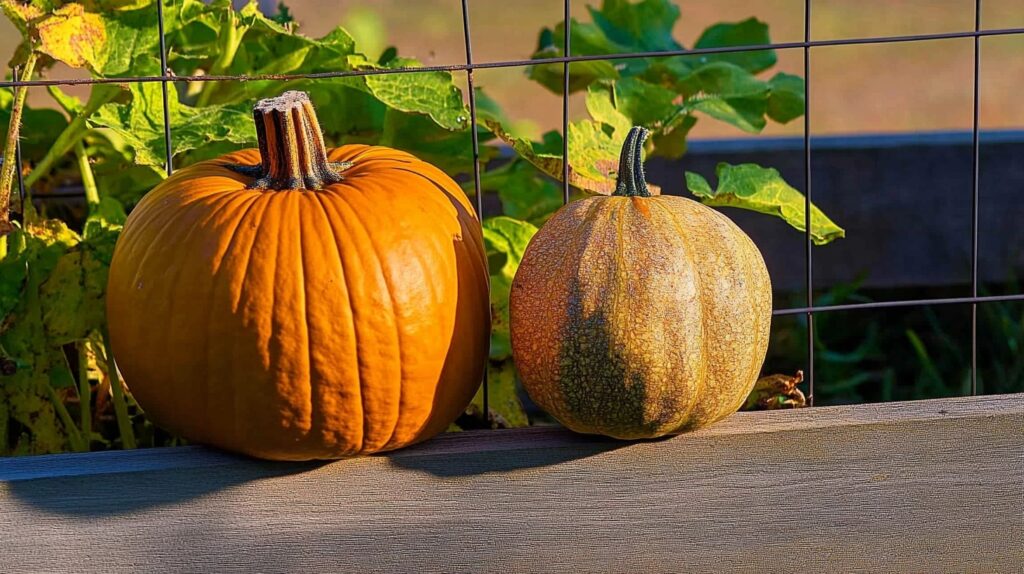
Not all trellises are created equal, especially when it comes to supporting vigorous vines and heavy fruit. Choosing the right trellis depends on your available space, the size of the pumpkin variety you’re growing, and your budget or DIY skills. Whether you’re repurposing what you already have or investing in a sturdy system, here are some of the top options for trellising pumpkins.
1. DIY Trellis
Ideal for small to medium pumpkin varieties, this option is both affordable and adaptable.
- Materials Needed: U-posts, heavy-duty nylon netting, zip ties
- Setup: Drive two 7-foot U-posts into the ground about five feet apart. Attach nylon netting (cut to about 5’x6′) using zip ties.
- Best For: Raised beds or containers. Position the trellis just behind your bed or container so the vines can easily reach it.
✅ Tip: Nylon netting and zip ties are gentle on vines and easy to adjust as the plants grow.
2. Pea Fence
This tall, foldable trellis offers a more polished look with excellent support for medium-sized gourds.
- Height: Usually around 8 feet tall
- Portability: Foldable design makes it easy to store or reposition
- Best For: Varieties like ‘Jarrahdale,’ ‘Triple Treat,’ or any medium-size pumpkin
✅ Tip: If using in a raised bed, stake it well into the soil to prevent tipping under the weight of growing fruit.
3. Tomato Cage
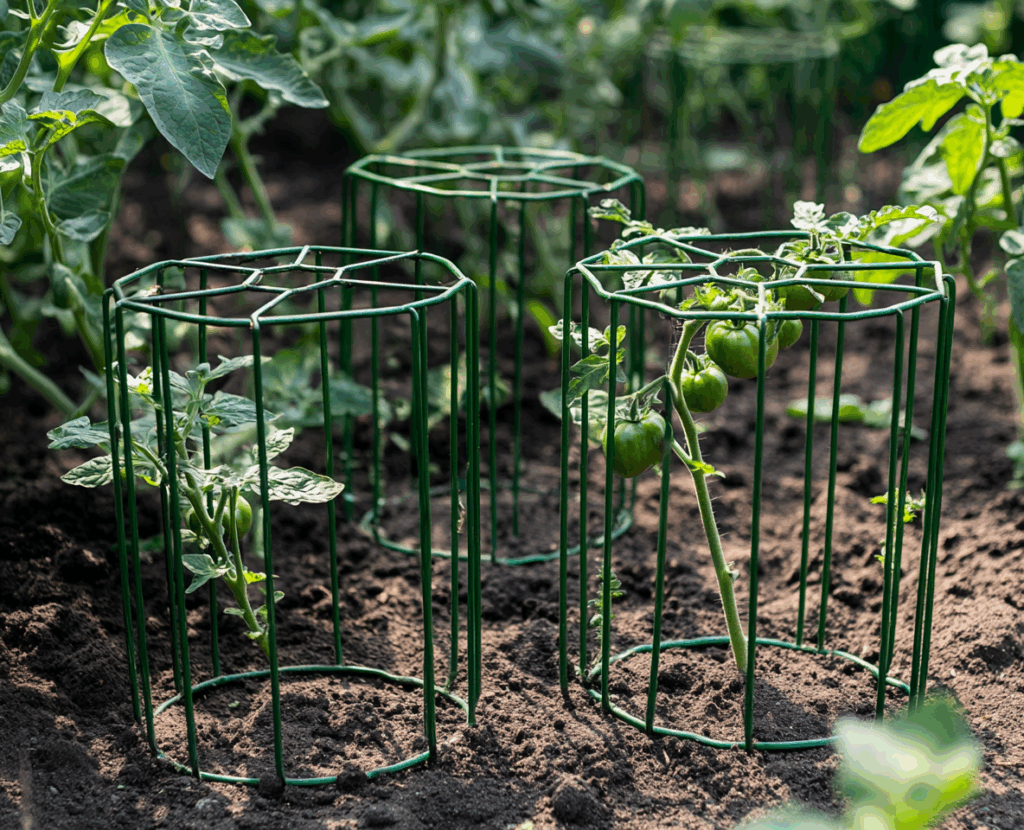
A tomato cage can do double duty when growing smaller pumpkins vertically—just make sure it’s a tall one.
- Size: Look for 54-inch or taller cages
- Pumpkin Varieties: ‘Jack be Little,’ ‘Small Sugar,’ or ‘Orange Smoothie’
- Space-Saver: Perfect for patios and small gardens
✅ Tip: Reinforce the cage with additional ties or stakes if your vine grows aggressively.
4. Trellised Arbor
Looking to turn your pumpkin patch into a garden showpiece? A trellised arbor combines beauty with function.
- Height: Usually around 7 feet or taller
- Design: Arched structure with built-in planting boxes
- Best For: Heavy varieties like ‘Howden,’ ‘Musquee de Provence,’ or ‘Jack-O-Lantern’
✅ Tip: A robust arbor can double as a garden entrance, giving you both visual appeal and excellent vertical support.
Training Young Plants to Climb
Once your trellis is in place, the next step in trellising pumpkins is guiding your plants to grow upward instead of sprawling out. Start early, and you’ll save yourself time and tangled vines later in the season.
Planting by Hardiness Zone
Depending on where you live, your planting method may vary slightly:
- Zones 7–9: Direct sow seeds right next to your trellis about a week after the last frost. Plant seeds 1 inch deep, keep them moist, and expect germination in 5–10 days.
- Zones 3–6: Start seeds indoors in biodegradable peat pots. Once your seedlings have 2–3 true leaves, transplant them outdoors near your trellis after the last frost.
✅ Pro Tip: Whether transplanting or sowing directly, always place your seeds or seedlings within a few inches of the trellis so vines naturally reach for it as they grow.
Training Tips for Young Vines
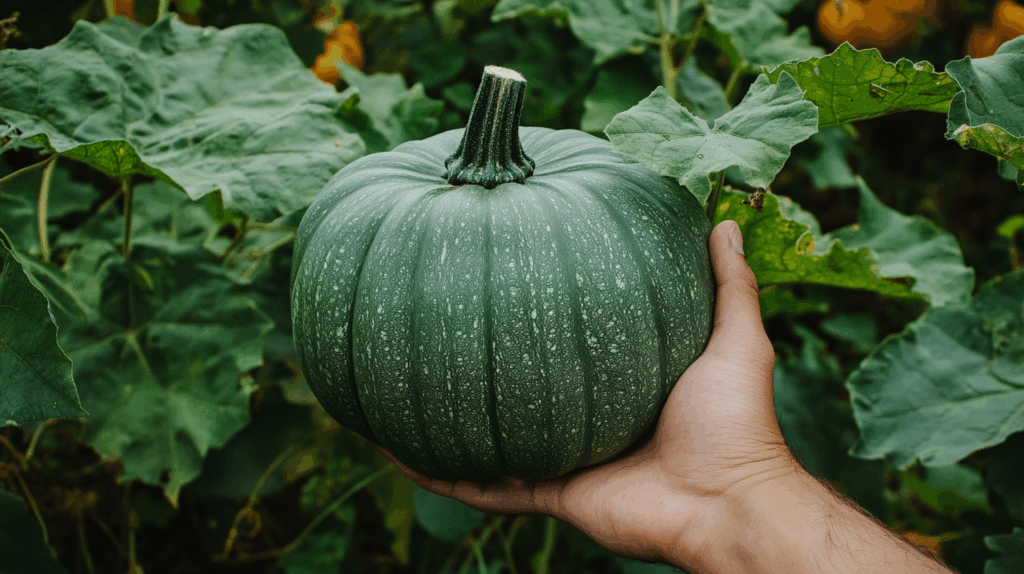
When those delicate pumpkin vines start reaching, it’s time to step in and guide them:
- Use Garden Twine or Soft Ties: Gently tie the main vine to your trellis with soft twine. Don’t cinch it tight—leave room for growth and airflow.
- Support Floppy Growth: Add additional ties further up the vine every few inches as it grows.
- For Lattice or Netting: You may not need any ties at all! Simply weave the vine through the structure as it climbs.
✅ Check Daily: Vines grow fast, and early training is essential. Check on them each day to reposition growth, add ties, or reweave where needed.
Encourage Pollination
Vertical growth also helps with pollination. By maintaining an open, airy structure:
- Flowers are more visible and accessible to bees
- There’s less leaf crowding, reducing missed pollination opportunities
If bees aren’t active in your area, consider hand-pollinating to ensure good fruit set.
Supporting the Fruit

Once your vines start setting fruit, you’ll need to give those growing gourds a helping hand. While the trellis supports the plant, it’s not built to carry the weight of pumpkins hanging midair—especially the larger varieties. That’s where fruit slings come in.
Why Fruit Support Matters
As pumpkins develop and gain weight, the stress on the vine increases. Without proper support, fruits may:
- Snap off prematurely
- Pull down or warp your trellis
- Weaken or damage the main stem
Trellising pumpkins works best when you plan for fruit support as early as possible.
How to Make a Fruit Sling
You don’t need expensive tools to cradle your pumpkins. Try these simple, DIY options:
- Mesh produce bags – The kind you find with onions or citrus
- Old T-shirts or pantyhose – Soft and stretchy, perfect for gentle support
- Reusable netting or garden fabric – Tied securely to the trellis on both sides
✅ Tip: Secure each sling to the trellis above the fruit, not the vine itself. This way, the growing weight is fully supported without straining the plant.
When to Sling the Fruit
- Start slinging when pumpkins are about the size of a softball.
- For larger varieties, consider doubling up the fabric or using a small bamboo hoop beneath the fruit to spread the weight.
- Check slings regularly as fruits grow and adjust for comfort and fit.
What Not to Do
- Don’t let heavy pumpkins dangle unsupported—vines can only hold so much!
- Avoid tying slings too tightly around the fruit, which can cause damage or deformity as they grow.
Final Tips for Trellising Pumpkins
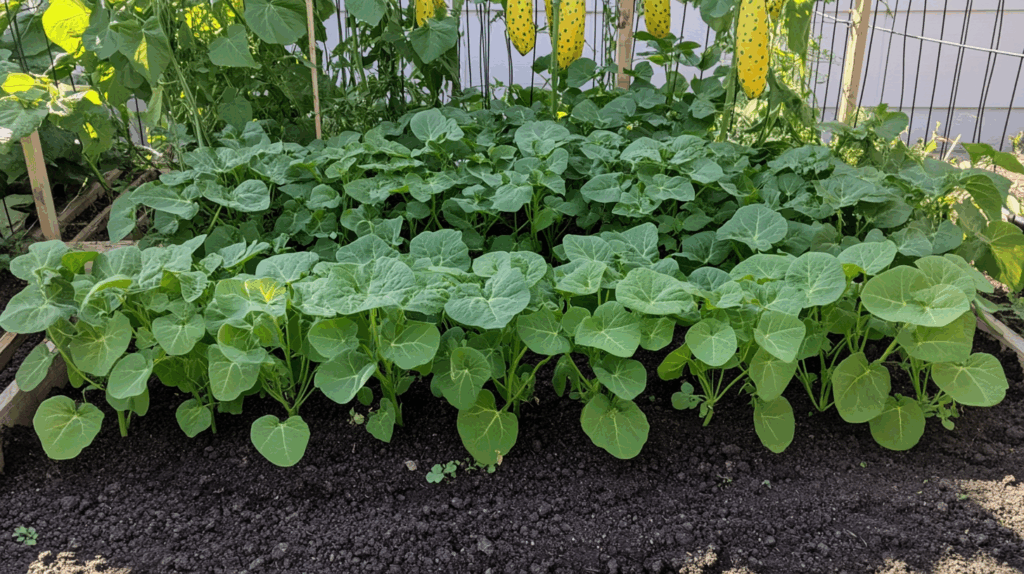
Growing pumpkins vertically might seem unconventional at first, but once you try it, you’ll wonder how you ever managed without it. With a bit of early planning and daily care, trellising pumpkins can completely transform your gardening experience—especially in smaller spaces.
Here’s a quick recap of key tips to ensure success:
- Start with strong support. Whether it’s a DIY frame, a tomato cage, or a decorative arbor, your structure needs to be tall and sturdy enough to handle mature vines and fruit.
- Train early and often. Begin guiding your vines as soon as they’re long enough to reach the trellis. Weave or loosely tie them in place and keep growth upright.
- Use slings for heavy fruit. Don’t leave developing pumpkins hanging—support them with netting, cloth, or old produce bags to prevent breakage.
- Monitor daily. Check for pests, guide vine growth, and maintain airflow to encourage pollination and prevent disease.
- Perfect for small gardens. Vertical pumpkin gardening saves space, reduces rot and pests, and creates a cleaner, easier-to-manage garden.
Whether you’re growing ‘Jack be Little’ in a patio container or ‘Musquee de Provence’ on an arbor trellis, this method opens up exciting possibilities for gardeners of all kinds.
Frequently Asked Questions (FAQ) About Trellising Pumpkins
Can all types of pumpkins be grown on a trellis?
Not all pumpkin varieties are suitable for trellising pumpkins, but many can thrive with the right support. Smaller and medium-sized pumpkins like ‘Jack Be Little’, ‘Triple Treat’, and ‘Jarrahdale’ are perfect candidates for vertical growing. Larger varieties can also be trellised, but you’ll need sturdy structures and well-positioned fruit slings to support their weight safely.
If you’re working with limited space, trellising pumpkins alongside compact crops can make a big impact. Check out these creative small vegetable garden ideas to design a layout that works vertically and efficiently.
How tall should a pumpkin trellis be?
When trellising pumpkins, aim for a trellis that stands at least 5 to 7 feet tall. Since pumpkin vines can stretch up to 20 feet in length, the taller your structure, the more growing room you’ll give your plants—especially if you’re working with larger or vining varieties. Just be sure the trellis is securely anchored to support both wind and the weight of developing fruit.
Need a structure that’s both sturdy and space-efficient? Explore these DIY garden trellis ideas to build one that suits your setup.
Do pumpkin vines need to be tied to the trellis?
Often, yes—especially in the early stages of trellising pumpkins. Use soft garden twine, cloth strips, or plant ties to gently secure the main vine as it grows upward. Some trellis structures, like lattices or nylon netting, offer the advantage of letting you weave the vines through the gaps, eliminating the need for frequent tying.
If you’re looking for easy, low-stress support techniques, check out these creative DIY pea trellis ideas—many of the same principles apply when training pumpkins too.
When should I start training the vines?
As soon as the vines are long enough to reach your support structure—usually when the plant has 2–3 true leaves. Early training helps the plant grow in the right direction from the start.
What can I use to support heavy pumpkins?
When trellising pumpkins, supporting the fruit is crucial—especially for larger varieties. DIY slings made from mesh produce bags, old T-shirts, pantyhose, or garden fabric are excellent options. Just be sure to secure the sling to the trellis frame itself, not the vine, to prevent stress or breakage as the pumpkin grows.
For more creative ideas on how to build structures that can handle the weight, explore these innovative garden trellis ideas designed for vertical growing success.
Does vertical gardening affect pumpkin yield?
Not negatively—in fact, it often improves results. Trellising pumpkins can enhance airflow and sun exposure, reduce disease risk, and even make pollination more efficient, especially in tight spaces. These factors contribute to stronger plants and bigger, cleaner yields.
To boost your overall harvest potential, consider combining trellising pumpkins with shade-tolerant vegetables or other compact companion crops that thrive in small or partially shaded gardens.
Conclusion: Grow Up, Not Out
Trellising pumpkins is more than a clever gardening trick—it’s a smart, space-efficient solution that improves airflow, reduces pest damage, and helps your pumpkins grow healthier and cleaner. Training your vines vertically not only tames their wild sprawl but also gives each fruit the strength and support it needs to mature beautifully.
From selecting the best trellis to securing slings and guiding vines, every step in trellising pumpkins adds up to a more manageable and rewarding gardening experience. Whether you’re working with a spacious backyard or a cozy patio garden, vertical pumpkin growing allows you to create a stunning and productive setup.
Looking for more inspiration on growing upward? Browse these garden trellis ideas for vertical gardening to expand your vertical growing strategy beyond pumpkins.
🌿 Love gardening inspiration? Follow me on Pinterest for bold plant ideas, tips, and seasonal color!
More Posts
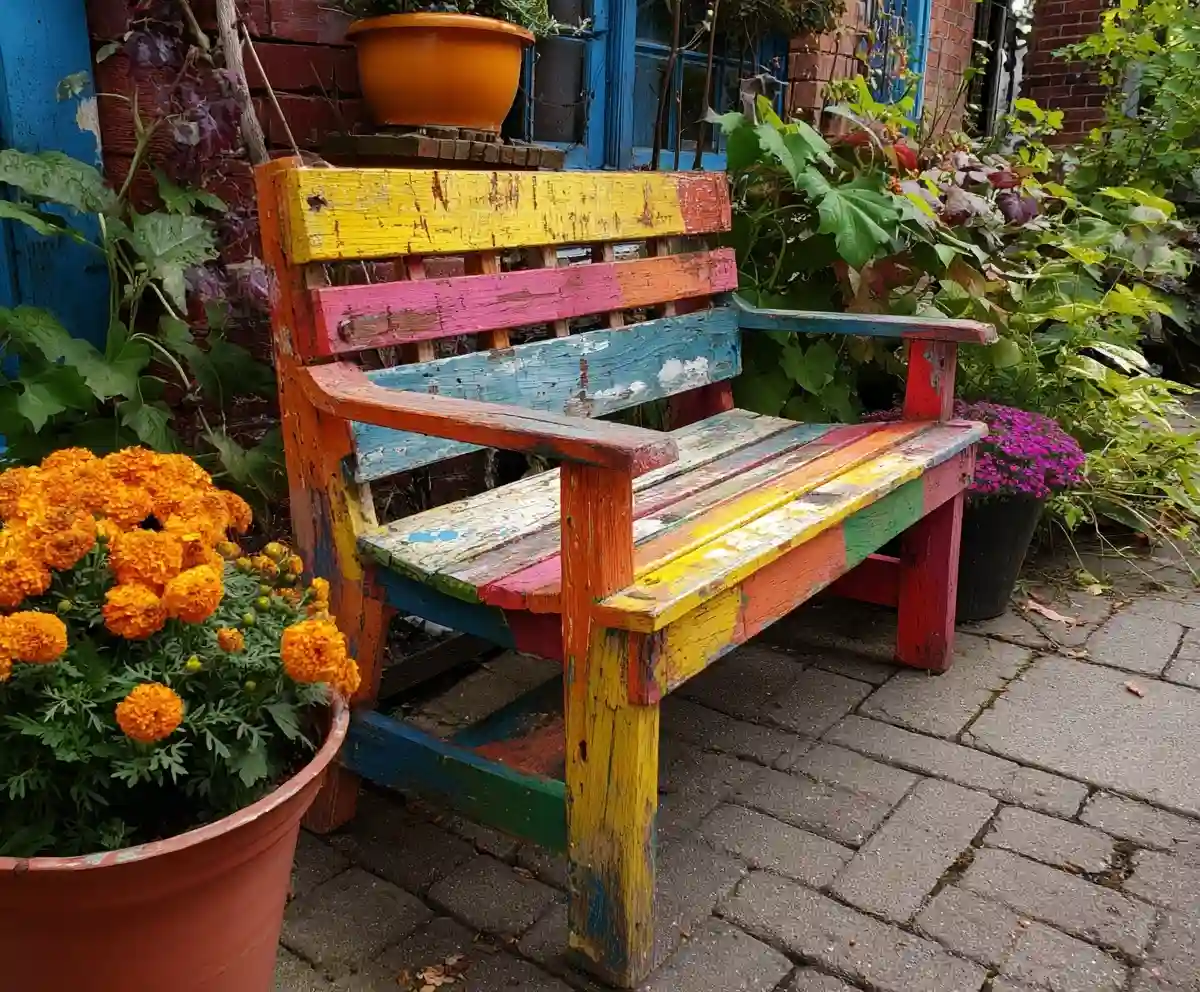
19+ Budget-Friendly Backyard Makeover Ideas
Backyard makeover ideas can turn even the most ordinary outdoor space into a warm, inviting retreat—without draining your wallet.
Read More →
21 Stunning & Simple DIY Clematis Trellis Designs
DIY clematis trellis designs are a beautiful way to blend creativity with function in your garden.
Read More →
12 Full Sun Perennials That Bloom All Summer
Explore a selection of hardy perennials that flourish and bloom beautifully in full sun throughout the summer.
Read More →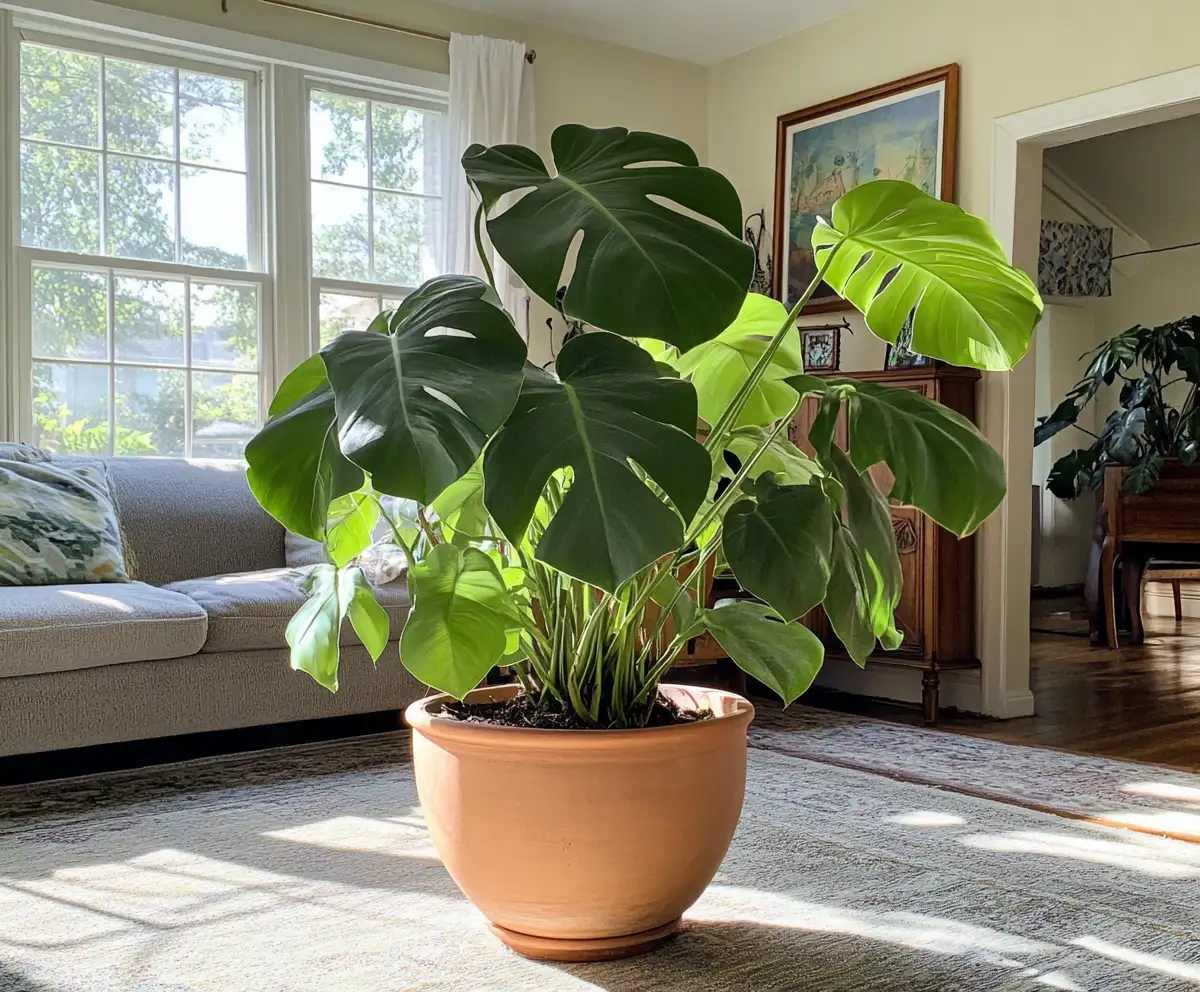
Houseplants for Living Room
Find the perfect houseplants to brighten and purify your living room while adding a touch of nature indoors.
Read More →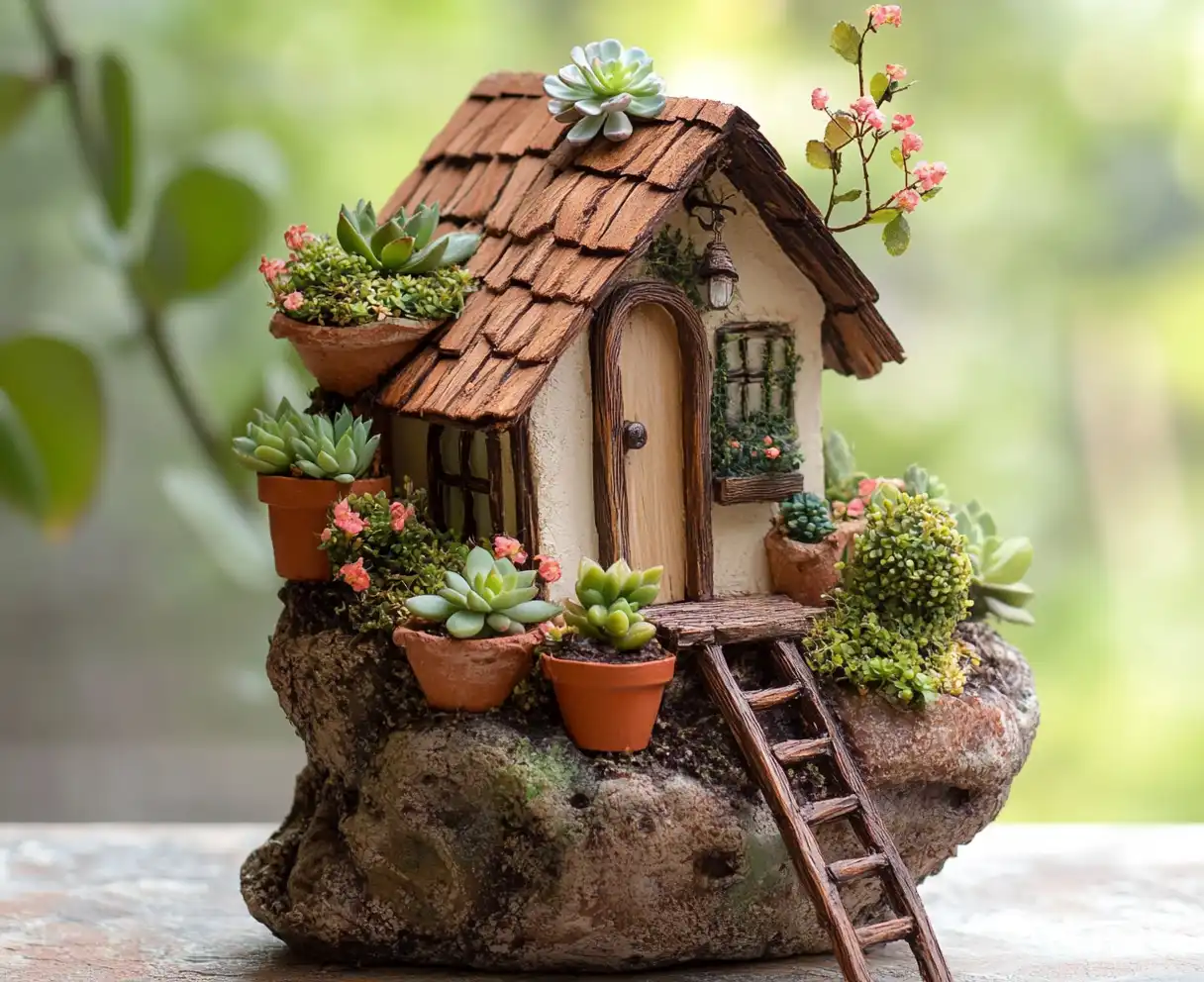
Backyard Play Area for Kids
Create a fun and safe backyard play area for kids with these inspiring design ideas and tips.
Read More →
Top Privacy Trees
Discover top tree varieties that provide natural privacy and enhance your outdoor space.
Read More →
